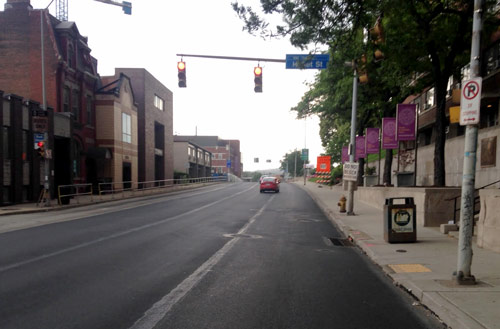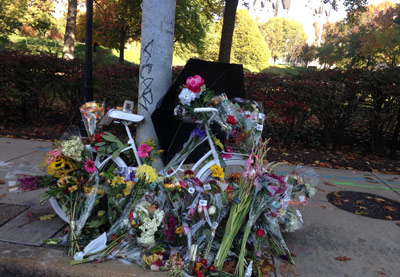Common-sense, Low-cost, Short-term Strategies for Safer Urban Streets
I’ve been getting around primarily on a bicycle for over 15 years in different cities. Last year I moved from Pittsburgh’s East Liberty area to Uptown, aka Soho/the Bluff, which connects Downtown to Oakland, the city’s education and medical center, and points east. I now have a longer ride to work, which I do not mind—more time on my bike makes me happy. The downside is that Oakland’s main avenues are some of the very last in the city to receive any attention in terms of bike and pedestrian infrastructure. The problem is complex, and planning initiatives have produced some great long-term ideas for a safer, multi-modal corridor along Forbes and Fifth avenues. But what about the short term? Does it really make sense for ten or more years to pass before even making the most minor improvements?

A freshly paved section of Fifth Avenue in 2015 has had no added sharrows, bike lanes or new signs to help make it a safer route.
After hearing about the City’s strategy to focus only on side streets for the time being, while allowing extremely dangerous conditions to stay the way they are on two of Pittsburgh’s most important roads, I could not continue to commute to and from work on my bike every day without my mind running through all of the different obvious ways that traffic conditions could be improved without a major long-term investment. I think it’s time to implement some quick interim solutions in order to keep people safe, so I’ve come up with the following six strategies.
- Carving out dedicated lanes from excess road width
Studies show that excess lane width makes motorists more likely to speed, swerve or drift. Narrowing lanes for cars can improve safety for everyone on the road and in many places would allow for a dedicated bike lane that isn’t in place yet. Paint is the least expensive type of road infrastructure, and doesn’t require long-term commitment because it can easily be changed. Similarly, there may be some places where the road is too narrow for a dedicated bike lane, but sidewalks are wide enough for bike riders to borrow space for a bike lane—remember to look at all the options in figuring out where to paint markings for bikes!
- “Bikes Use Ped Signal” ordinance and signage
 Some intersections in Pittsburgh have signals with a cycle that includes a 4-way pedestrian module in which all vehicular traffic stops. Bike riders most often take this 20 seconds to make otherwise frightening left turns, or to get a head start among car traffic. The City should make it official policy that bicycle riders can use these pedestrian signals as “go” signals for bikes as well, and make it clear that bike riders must yield to pedestrians who are crossing the street.
Some intersections in Pittsburgh have signals with a cycle that includes a 4-way pedestrian module in which all vehicular traffic stops. Bike riders most often take this 20 seconds to make otherwise frightening left turns, or to get a head start among car traffic. The City should make it official policy that bicycle riders can use these pedestrian signals as “go” signals for bikes as well, and make it clear that bike riders must yield to pedestrians who are crossing the street.
A bonus aspect to such a policy for Pittsburgh cyclists would come from a 5-second head start walk signals that was implemented throughout much of the city years ago. Giving bike riders the extra 5 seconds to get moving before the cars behind us start tailgating and honking at us would be helpful.
The policy can be communicated through very simple signs, which have already appeared in some places along the downtown Penn Avenue bikeway. The signs read “Bikes Use Ped Signal”.
- Shared lanes for transit and bicycle riders
In some places around town, planners have claimed that roads aren’t wide enough for Bike lanes. While I usually would disagree, citing bike infrastructure in European cities with far more narrow streets, I would settle for lanes along Forbes and Fifth Avenues that are designated for buses and bikes only. A section of Fifth already has a bus lane going one way that could be changed literally overnight to allow bike riders as well. Creating bus+bike lanes going the other way on Fifth and also in the far-right lane on Forbes would be safer for bike riders and could also improve traffic flow for busses and cars.
Obviously, bus operators will need a little additional training to help clarify some right-of-way protocols. I think that all public transportation drivers should be required to spend a bit more time in training that focuses on safety around pedestrians and people on two wheels—I have certainly had my share of frightening encounters with inattentive or sometimes even reckless or aggressive professional drivers (especially licensed taxi drivers).
- Speed control measures and traffic law enforcement for shared roadways
Most of our city streets, including Fifth and Forbes Avenues between Oakland and Downtown Pittsburgh have a posted speed limit of 25 MPH. Too many drivers ignore the speed limit, and in over a year of daily commuting I have yet to see even one motorist get pulled over by police for speeding or blasting through a red light—not one! It’s also clear that there is practically no enforcement of Pennsylvania’s 4-feet passing law designed to prevent car crashes with bicycle riders. Overall, the lack of attention to speed and basic traffic laws make our roads terribly unsafe. And, an especially disturbing behavior that I see happening among those driving near me on the road is typing on a smart phone or doing something else while accelerating with NO HANDS on the steering wheel! That’s also against state law, but you would never know it based on how widespread distracted driving has become.
It is time for motorists to take responsibility for their driving and commit to safety. A city-wide campaign is necessary to remind commuters of this, and the cops need to be there every day enforcing the law. Placing some police on bicycles who can ride up and down Fifth and Forbes would also be a game-changer. It would be easier for a cop on a bike to see into cars in which the driver may be texting with their eyes off the road for minutes at a time. Seeing police on bikes would also affirm the rights of bike riders to be on Fifth and Forbes, which is really half the battle. I cannot tell you how often I get a car tailgating me, sometimes honking, sometimes screaming that I should not be on the road, and on one occasion throwing a soda bottle at me. Would they be driving like this if there were a cop on a bike or a police car in sight? I doubt it.
- ”Look for bicycles” signs in door zone bikeways
A community meeting I attended recently had several bike riders complain that the City places most separated bike lanes in the door zone alongside parked cars, creating a dangerous condition when people open their car doors. This one is a no-brainer. If planners cannot figure out a better place to put bike lanes, at least place signs at the curb every few car lengths to remind those parking their cars to watch out for bike riders approaching in the lane next to them. This can help us avoid some really painful injuries.
- Prioritize fixing potholes along existing bike routes
Pittsburgh is known for streets that are riddled with potholes—some so severe that it’s quite common for people to swerve around them in their cars in order to avoid a flat tire or other damage. For those of us on bikes, even minor potholes are very destructive, and they make biking through a corridor like Fifth-Forbes incredibly dangerous. Other streets that the City has already designated as preferred bicycle routes by painting sharrows or separated bike lanes, such as Millvale Avenue, Neville Street, Centre Avenue, and Friendship Avenue, are in desperate need of some pothole triage.
Since Mayor Peduto took office in 2014, his administration has done a lot to fix potholes all over the city. He even instituted a program called “Pothole Blitz” that invites citizens to call, tweet, or email 311 to report potholes along their commuting routes. Those that more people point out are prioritized for repairs.
It would be fantastic to have the City look specifically at the streets that they tell bike riders to use and prioritize those for pothole repairs. These repairs will benefit everyone, no matter their mode of transportation.
The Time for Action is Now
Over the weekend while I was preparing this post, a 34 year-old woman who was waiting at a red light on Forbes Avenue while riding her bike home from work Friday night was rear-ended and sandwiched between two cars. She died in the hospital shortly after the crash, which may not have directly been anyone’s fault (authorities are still not decided on what caused a motorist two cars behind the cyclist to crash into the car in front of it). While it may not be productive to look for someone to blame for this tragic loss of life, we need to recognize that it was preventable and that we have a responsibility as a city to examine the conditions that allowed the accident to happen.

A “ghost bike” to honor the woman killed at a red light while waiting on her bicycle was installed during a memorial service organized by Bike Pittsburgh.
On the block where the accident happened, there is more than enough width for a dedicated bike lane, which is one way that people who aren’t encased in a heavy steel vehicle can be safer, with cars, trucks and buses kept on a separated part of the street. Implementing the strategies above as part of a comprehensive road-safety campaign could help shift our commuter culture towards one of mutual responsibility and compassion—simply installing bike lanes would not be enough, and putting off any sort of action for even a few more months would be negligent and dangerous. Hundreds of Pittsburghers came out in the rain the day after the crash to mourn with the victim’s family and friends and to demand safer streets in Oakland and throughout Pittsburgh.
Just three days later and not far from the bicycle-involved crash, a person in a wheelchair and a pedestrian were killed in a crash as well, reportedly after they got off of a Port Authority bus. Every year in Pittsburgh, over 200 people are hit crossing our streets. Let’s hope that no one else has to die before our leaders and communities come together to implement some common-sense safety measures on our most prominent arterial streets.

